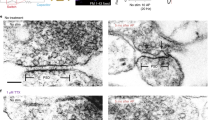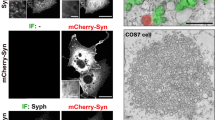Abstract
SYNAPTIC vesicles have assumed a role of singular importance in models of synaptic function as morphological evidence of their existence appeared simultaneously with the “quantal” theory of transmitter release1. The problem of synaptic vesicle origin, essential to understanding this role, has led to extensive investigations. Electron microscopic studies2–4 have demonstrated synaptic vesicles attached to the axolemma or open to the extracellular space, and suggest that some synaptic vesicles form by a process of micropinocytosis at the presynaptic terminal membrane. Freeze-etched preparations, besides showing smaller micropits (synaptopores) at presynaptic sites, have shown similar plasmalemmal vesicles at non-synaptic sites5. A micropinocytotic origin of synaptic vesicles remains uncertain, however, and other workers suggest an intracytoplasmic mechanism of origin6,7.
This is a preview of subscription content, access via your institution
Access options
Subscribe to this journal
Receive 51 print issues and online access
$199.00 per year
only $3.90 per issue
Buy this article
- Purchase on Springer Link
- Instant access to full article PDF
Prices may be subject to local taxes which are calculated during checkout
Similar content being viewed by others
References
Del Castillo, J., and Katz, B., Prog. Biophys. Chem., 6, 121 (1956).
Westrum, L. E., J. Physiol., 179, 4p (1965).
Hubbard, J. I., and Kuanbunbumpen, S., J. Physiol., 194, 407 (1968).
Bunt, A. H., J. Ultrastruct. Res., 28, 411 (1969).
Akert, K., Pjenninger, K., Sandri, C., and Moor, H., in Structure and Function of Synapses (edit. by Pappas, G. D., and Purpura, D. P.), 79 (Raven, New York, 1972).
Stelzner, D. J., Z. Zellforsch., 120, 332 (1971).
Pelligrino de Iralde, A., and De Robertis, E., Z. Zellforsch., 87, 330 (1968).
Brightman, M. W., in Brain Barrier Systems (edit. by Lajtha, A., and Ford, D. H.), 20 (Elsevier, Amsterdam, 1968).
Vaughn, J. E., and Peters, A., J. Anat., 100, 687 (1966).
Graham, R. C., and Karnovsky, M. J., J. Histochem. Cytochem., 14, 29 (1967).
Karnovsky, M. J., J. Cell Biol., 35, 213 (1967).
Brightman, M. W., J. Cell Biol., 26, 99 (1965).
Gray, E. G., and Willis, R. A., Brain Res., 24, 149 (1970).
Ceccarelli, B., Hurlbut, W. P., and Mauro, A., J. Cell Biol., 54, 30 (1972).
Heuser, J., and Reese, T. S., Anat. Rec., 172, 329 (1972).
Holtzman, E., Phil. Trans. Roy. Soc. Lond. B., 261, 407 (1971).
Bloom, F. E., Iversen, L. L., and Schmitt, F. O., Neurosci. Res. Program Bull., 8, 325 (1970).
Author information
Authors and Affiliations
Rights and permissions
About this article
Cite this article
TURNER, P., HARRIS, A. Ultrastructure of Synaptic Vesicle Formation in Cerebral Cortex. Nature 242, 57–59 (1973). https://doi.org/10.1038/242057a0
Received:
Revised:
Issue Date:
DOI: https://doi.org/10.1038/242057a0
This article is cited by
-
Intracellular localization of acetylcholinesterase in nerve terminals and capillaries of the rat superior cervical ganglion
Journal of Neurocytology (1978)
-
Synaptic vesicle recycling in synaptosomes in vitro
Nature (1976)
-
Ultrastructural studies of normal and degenerating mouse neuromuscular junctions
Journal of Neurocytology (1975)
-
Endocytotic formation of rat brain synaptic vesicles
Nature (1974)
-
Observations on uptake of Herpes simplex virus in organized cultures of mammalian nervous tissue
Acta Neuropathologica (1974)
Comments
By submitting a comment you agree to abide by our Terms and Community Guidelines. If you find something abusive or that does not comply with our terms or guidelines please flag it as inappropriate.



